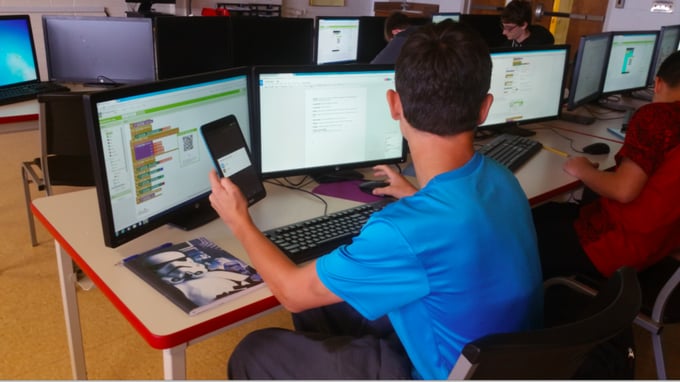Patricia Piros is a PLTW Introduction to Computer Science (ICS) Teacher. She teaches at East Providence Career & Technical Center in East Providence, Rhode Island.
PLTW assignments are project-based, and through them, my PLTW Computer Science students are learning the necessary skills that will help them in life. As students progressed through the assignments in Introduction to Computer Science, for example, they were challenged to break down different problems and empowered to build their analytical skills.
At the start of the school year, I had 10 students in 9th grade, two 10th grade students, and one 11th-grader come into my class with varying levels of ability. Some boys knew each other, and a few were very shy. We started off with setting up a routine where students would come into the class and work on a task analysis in which they would have to analyze the code and determine any errors. Then we worked on instruction, and finally, students would work in teams or in groups to complete a project.
At first I received a lot of resistance on who was working with whom. I learned the dynamics of the students and what ability levels were. I also saw who worked well together. As the year progressed, I switched up groups/teams so the students could learn how to work with different people, find out what their styles are, and overcome obstacles. Again, there was resistance; however, I saw students tapping into each other’s strengths and working out problems that they wouldn’t have even attempted previously. I watched the class work together on projects as a whole group and as individuals. I was able to witness the shy student come out of his shell and lead a group to a successful project. It was nice to hear students say they worked outside of school to complete projects where they would not have done so in the past.
Typically, conversations in group work tend to go off task. But in order to meet deadlines, students worked together and assigned different roles to each member of the group, tapping into strengths. I observed struggling students work tirelessly to accomplish the task. They would research something they didn’t know or ask a member from another group to help them.
As a teacher in a blended-learning environment, I am able to sit with students who are struggling and also students who are advanced and want to learn something that is not part of the curriculum. Working with PLTW allows for students to explore beyond what they have learned and share with others who want to learn. It’s nice to see this happen and watch the boys gather around a computer to see what another student has discovered in programming and what effects it has on their program, especially when the students go back to their workstation to see if they can get the code to work on their project. These are the moments that I really enjoy experiencing because it shows me that all students are learners, and they are able to learn through PLTW.
PLTW’s blog is intended to serve as a forum for ideas and perspectives from across our network. The opinions expressed are those of this guest author.

